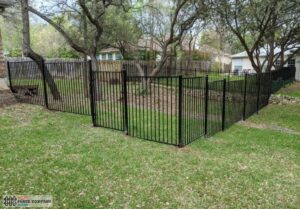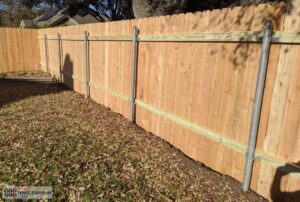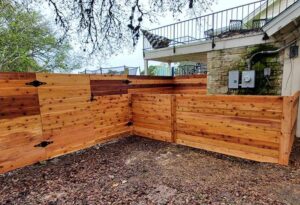Preventing Post Rot in Austin’s Clay Soils
TL;DR:
Austin homeowners face unique challenges due to local soil and weather. Austin’s expansive clay holds water against wood at the ground line—the exact zone where decay fungi thrive. To prevent post rot and ensure effective fence repair, use proper materials to prevent fence post rot in Austin. Specify ground-contact–rated materials (AWPA UC4B+), drainage at the base (gravel bed), a concrete “collar” crowned above grade, and a sealed ground-line zone (barrier sleeve/bituminous wrap). Consider galvanized steel posts for the longest life. Keep irrigation off posts, maintain 2–3 in. soil clearance, and re-stain every 2–3 years. If you’re starting from scratch, drainage design and selecting the right materials are key during fence installation.
During the rainy season, the risk of post rot increases, so Austin homeowners should be extra vigilant with maintenance and preventative measures at that time.
Table of Contents
ToggleWhy Fence Posts Rot in Austin (and Where It Happens Most)
One of the most common challenges Austin homeowners face is fence post rot. At Atlas Fence Company, we frequently observe premature post failure resulting from a combination of soil conditions, moisture, and improper installation techniques. Understanding where and why rot develops can help you prevent costly repairs and extend the life of your fence.
The “Rot Bullseye”: The Ground Line
Fence posts rarely rot at the buried tip—it’s the ground line, about 1–3 inches above or below grade, where decay is most aggressive. Austin’s clay soils hold moisture in this zone, while oxygen is still present, creating the perfect environment for fungi and microbes. Over time, wet rot sets in, and if rotting wood isn’t removed promptly, fungal spores can spread to other areas of the fence. What begins as a small crack or soft spot can quickly develop into a structural problem.
Expansive Clay Soil Movement
East Austin, Pflugerville, and areas of Round Rock sit on Blackland-type clays, which expand when wet and contract when dry. This movement pumps water and fine soil particles into post pockets, stressing posts and breaking weak concrete bonds. As a result, posts in these zones often rot and shift faster than in areas with more stable soil.
Irrigation and Mulch Build-Up
Landscaping practices can accelerate rot. Sprinklers, drip irrigation, and thick mulch beds keep the ground around posts wet during Austin’s hot summers. When moisture levels remain high at the ground line, wood fibers weaken, rot develops, and posts lose their load-bearing strength.
Hardware and Fastener Corrosion
Even metal components play a role in rot. Corroding fasteners and hardware open protective coatings, creating tiny pockets that trap moisture at the ground line. This combination of water and exposed wood fibers further accelerates decay.
Materials that last in clay

Wood posts
- Pressure-treated Southern Pine, AWPA UC4B (ground contact) or better for high-risk sites. UC4A is often sold as “ground contact,” but UC4B/UC4C performs better where soils are wet or poorly drained.
- Cedar heartwood resists decay better than sapwood, but cedar posts still rot if water is trapped at grade. Use barrier sleeves at the ground line.
- Size matters.4×6 posts have more heartwood and hold up better than 4×4 in clay.
- Choosing the right wooden fence post is crucial for the stability and longevity of a wood fence. Proper selection and installation help maintain the fence’s structure and prevent premature failure.
- When installing posts, ensure the post hole is deep enough and that you are properly mixing concrete to set the post securely. This is essential for the fence’s stability and long-term performance.
Steel posts
- Galvanized structural posts (e.g., C-channel or round/rectangular tube) avoid wood rot entirely. They pair with cedar or composite rails and pickets for a warm look with a long-life backbone.
- Specify hot-dip galvanizing and compatible hardware; for coastal or poolside chlorides, consider G185 or stainless hardware.
Barriers & wraps
- Heat-shrink bituminous sleeves (ground-line zone from ~2 in. above to 12–16 in. below grade) block oxygen and moisture where decay starts.
- Post boots or composite sleeves isolate wood from wet soil. If fully enclosing, provide weep paths at the bottom so water can escape.
Stains & finishes
- Semi-transparent stains highlight the wood grain, while solid stains provide a thicker, opaque coating that hides the natural wood appearance and offers maximum durability.
- Having your fence stained not only protects it from weather and UV damage but also enhances its appearance, helping to preserve the natural beauty of your landscape.
- These materials and treatments can significantly extend your fence’s lifespan by protecting against rot, decay, and weathering, ensuring your fence’s condition remains strong and attractive for years.
Installation details that stop rot before it starts
The goal is drainage and separation—let water out and keep oxygen from meeting wet wood at grade.
Hole prep
- Bell the bottom only if needed for uplift; otherwise, keep a flat, tamped 6–8 in. gravel bed under the post for drainage.
- In heavy clay, widen the top 8–10 in. slightly to accept a concrete collar that you can crown above grade.
Setting posts (wood)
- Wrap the ground-line zone with a barrier sleeve before setting.
- Do not fully encapsulate the post end in a bathtub of concrete. Instead:
- Set the post on the gravel bed.
- Add concrete as a perimeter collar around the upper half of the hole to lock alignment.
- Crown the top of the concrete 1–2 in. above grade and slope it away from the wood, leaving the barrier sleeve exposed and the bottom free-draining into gravel.
Setting posts (steel)
- Core-drill limestone where present; set with non-shrink grout or epoxy per spec.
- For soil sets, use a full concrete fill with a crowned top; galvanizing + paint at the ground line adds insurance.
Depth & spacing
- Typical residential 30–36 in. embedment (deeper for 8-ft fences or wind exposure).
- In expansive clay, reduce bay widths or upgrade post size to cut racking that cracks collars.
Hardware
- Use hot-dip galvanized or exterior-rated coated fasteners.
- Avoid mixing dissimilar metals; keep cut ends and field bores sealed.
Building new? Get these details baked into your scope during fence installation in Austin.
Above-grade protection: stains, sealers & smart maintenance

- Oil-modified or high-quality penetrating stains slow down the cycling of moisture. First application after wood’s initial dry-down; then re-stain every 2–3 years depending on sun + irrigation exposure. Applying stain is a crucial maintenance step that protects the wood by reducing porosity, preventing water absorption, and minimizing the risk of rot. Before staining, use a pressure washer on a gentle setting to remove dirt and grime, which helps maintain the fence’s appearance. Staining not only improves the fence’s appearance but also increases its durability. Need help choosing the right product and schedule? Tap our fence staining service.
- Keep grade down. Maintain a 2–3 in. soil/mulch gap below the bottom board/rot board so splashback doesn’t keep wood wet.
- Redirect irrigation. Angle heads away; avoid drip emitters near posts.
- Air gap for horizontals. If you’re using horizontal designs, create a ventilated backer system to prevent water from accumulating against the posts.
Troubleshooting & repairs for existing fences
- Softwood at grade, but post still solid? Add a barrier sleeve at grade (retrofit types exist), re-crown the collar, and divert sprinklers. These are common fence issues that many homeowners in Austin encounter.
- Localized rot at the ground line? Sister with a steel repair stake and sleeve; replace the post at the next panel refresh. Storm damage can also cause rot or deterioration at the ground line, requiring timely repairs.
- Multiple leaning panels? Clay movement likely broke collars. Leaning panels or posts can be early signs of structural problems that need prompt attention. Replace posts; use gravel base + crowned collars and consider upsizing to 4×6 or steel.
- Panels are fine, but posts are done? We can re-post and re-hang to save good panels—often cheaper than full replacement. Storm damage is a potential cause for needing repairs or replacement of posts.
Aging fence maintenance: keeping old posts strong
As your wooden fence ages, proactive maintenance becomes the key to preserving its strength and appearance. The fence posts are the backbone of your entire fence, so keeping them in top shape is essential for long-term durability. Start by inspecting your posts regularly for any early signs of rot, insect activity, or moisture damage—especially after heavy rains or during the humid summer months. If you notice any soft spots or discoloration, address them promptly to prevent further deterioration.
Applying a fresh coat of high-quality stain or sealant every few years helps protect your posts from UV rays, moisture, and pests. This extra layer not only enhances your fence’s appearance but also extends its lifespan by sealing out the elements. Don’t overlook the importance of proper drainage around your posts; ensure that water flows away from the base and that soil or mulch doesn’t build up against the wood. Installing or maintaining concrete footings can further prevent moisture from seeping into the posts, reducing the risk of rot.
By combining regular inspections, timely staining, and attention to drainage, you can protect your aging fence and keep your wooden fence posts strong for years to come.
When to seek professional help
While many homeowners can handle minor fence repairs, there are times when calling in professional help is the best way to protect your investment and maintain your property’s curb appeal. If you notice leaning posts, widespread rotting, or significant damage to your fence panels, it’s time to consult a fence repair expert. Professionals have access to quality materials and the experience needed to address structural issues safely and effectively.
Expert help is especially valuable when dealing with complex situations, such as navigating HOA guidelines, determining property lines, or working around underground utilities. A professional can also spot early signs of trouble that might go unnoticed during DIY repairs, helping you catch issues before they turn into costly repairs.
Regular maintenance and inspections by a professional can extend the life of your fence, ensuring it remains both attractive and secure. Don’t hesitate to seek professional help when your fence is showing signs of severe wear—your posts, panels, and property will thank you.
Austin-specific notes
- Soils change fast across town. East of MoPac, you’ll encounter more clay; west toward Lakeway/Steiner, you’ll see thin clay over limestone—we often core-drill and epoxy set there instead of digging traditional holes.
- Summer heat accelerates wood drying and cracking in Austin, increasing the risk of post-rot. Consider extra sealing or shade where possible.
- Termites are active. Use treated pine (UC4B+) or cedar heartwood and keep mulch low; never stack firewood against posts.
- Stormwater. Install French drains or simple swales if downspouts or slopes dump water on your fence line.
Process, timeline & ballpark pricing

- Site visit & soil check — we probe holes, check irrigation patterns, and identify clay vs. rock.
- Spec & design — material grade, post size, barrier method, footing details.
- Build — set posts with a gravel base + crowned collars; install rails, pickets, gates; stain scheduling.
- Walkthrough — care plan and maintenance calendar.
Typical timelines: 1–3 weeks from approval to installation of the window (seasonal).
Ballparks (installed):
- Wood posts (UC4B) + sleeves: $$
- Steel posts with cedar panels: $$–$$$
- Re-posting existing fence: $–$$ depending on access and panel salvage.
Have questions about pool areas or safety barriers? See our related guide: Pool-Safe Fence Design in Austin (Style + Code).
FAQs
Ask for AWPA UC4B (ground contact, severe) or better for posts touching soil in Austin’s clay. It’s the right grade for wet or poorly drained sites, significant for wood fences, which can benefit from wood preservatives.
The problem isn’t the concrete itself—it’s trapped water. A gravel base, combined with a crowned concrete collar that sheds water away from the wood, is the winning combination.
Yes, for longevity. They eliminate the risk of wood rot at the ground line, significantly improving the fence’s lifespan. And pair effectively with cedar or composite panels, offering an alternative to metal fences.
Plan on every 2–3 years to avoid costly repairs and check for early signs of wear. High-sun or irrigated zones may need it sooner.
Often, yes. You can perform diy repairs to re-post and re-hang solid panels to extend the life of an aging fence on a budget.
Ready to stop post rot?
Get a tailored spec for your soil type and yard conditions. Request a free estimate →
